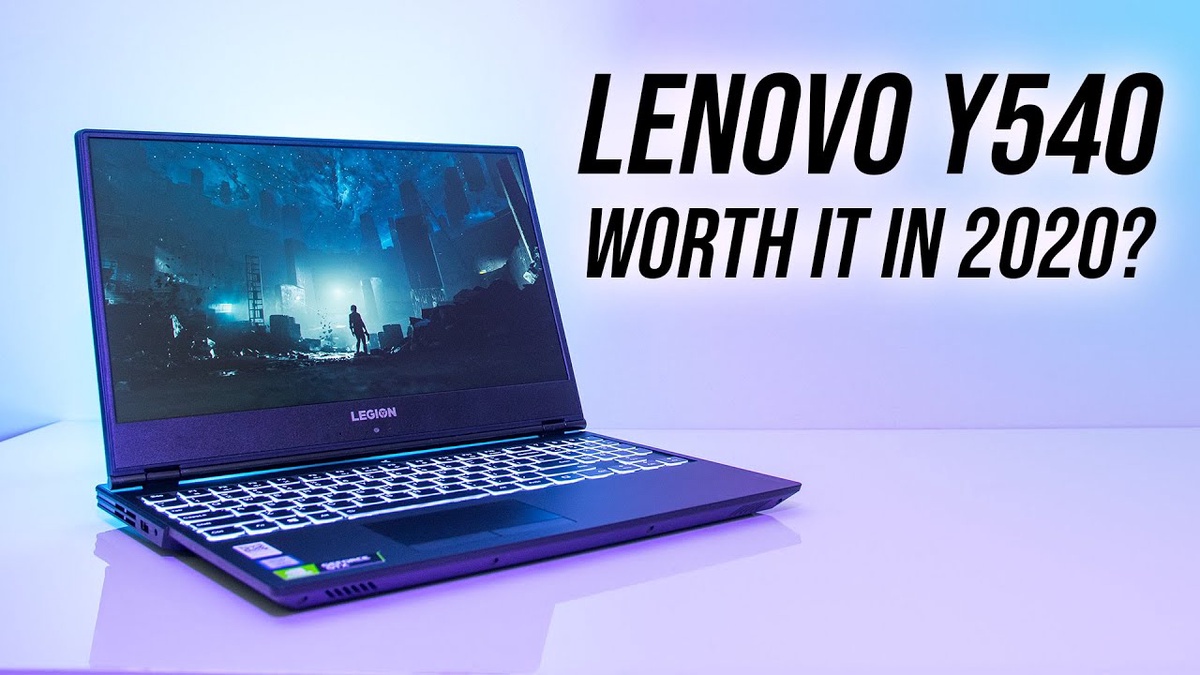The Lenovo Y540 is a great performing gaming laptop for the money, let’s find out how well it performs in 20 different games at all setting levels, and find out how performance has changed over the last year to see if it’s still worth it.
I’ve done a similar review to this with the Y540 already, but that was back in July 2019 with older games, older BIOS, older Windows, and older drivers. Given I still often recommend the Y540, I thought it would be useful to provide updated test results including newer game titles that didn’t exist back then. We’ll also compare some games with those tested previously and see if these updates have changed performance over time.
The configuration I’ve got has
- CPU: Intel i7-9750H
- Graphics: Nvidia GTX 1660 Ti (80 watt)
- Memory: 16gb DDR4-2666 in dual channel
- Storage: 512 GB NVME M.2 SSD
- Screen: 15.6” 1080p 60Hz/144HZ
The Y540 allows us to swap between three different performance modes through the Vantage software, and I’ve tested with the best performance mode for optimal results. It also allows us to disable the Intel integrated graphics by turning off hybrid mode, which will further boost performance.
No undervolting or overclocking has been done here, we’re just looking at essentially an out of box experience.
 Battlefield V was tested in campaign mode going through the same part of the game for each test. I’ve got the fresh new results shown by the purple bars, and the results from 7 months ago in the red bars. We can see that over time there have been some nice improvements with this game, which almost performs 12% better at ultra settings now.
Battlefield V was tested in campaign mode going through the same part of the game for each test. I’ve got the fresh new results shown by the purple bars, and the results from 7 months ago in the red bars. We can see that over time there have been some nice improvements with this game, which almost performs 12% better at ultra settings now.
Red Dead Redemption 2 was tested using the game’s built in benchmark tool, and it wasn’t out the last time I tested this laptop so there’s no data to compare it with. High settings wasn’t able to hit a 60 FPS average, however this is a pretty resource heavy game to run.
Control was another game that was released after my initial review of the Y540, and it was playing well enough with the highest setting preset, however going down to medium still looked good enough and even the 1% low performance was higher than the average from high settings.
Shadow of the Tomb Raider was tested with the games benchmark tool, and there was a 3 FPS boost with all of the newer updates in place compared to last years testing, with the exception being at the lowest setting preset which scored the same.
Apex results need a bit of explanation. I tested the fresh results in Season 2 and the old results in Season 1 with different maps, so the results aren’t directly comparable, however Nvidia did release improved drivers for this game after my original test which greatly boosted overall performance, as we can see at max settings there’s a big difference as this game has gotten much better over time in terms of FPS.
Call of Duty Modern Warfare was tested in campaign mode, and I’ve also tested it with the settings either maxed out or at minimum due to there not being setting presets available. Unfortunately this game wasn’t out when I originally tested the Y540, so nothing to compare it with, however even max settings was capable of above 60 FPS averages.
The Division 2 was tested with the games benchmark tool, and the older results were a little better between medium and high settings, however the average FPS at low settings was a fair bit higher with the newer testing.
Borderlands 3 was also tested using the game’s built in benchmark, and was another game that wasn’t available to test when I originally covered the Y540. 60 FPS averages were just able to be reached with the high setting preset with this machine.
Ghost Recon Breakpoint was also tested with the benchmark tool, and was another that wasn’t available the last time I tested out this laptop. Ultra settings was just able to hit 60 FPS in this test, so not too bad.
Like Apex, the Fortnite results aren’t really directly comparable, as the 2020 results were tested with chapter 2 which wasn’t out when I originally tested the Y540, so completely different map, though despite this the differences weren’t too big.
Overwatch is another less demanding game and was tested in the practice range, so the exact same test run through the game. The averages are quite close together, however there’s a bigger difference noted in the 1% low results at ultra and epic settings.
CS:GO was tested using the Ulletical FPS benchmark, and it already sees above average results as higher frame rates work better with the option of disabling Optimus, however there were still some nice improvements over the results from last year.
Dota 2 was tested playing in the middle lane, and the average frame rates were very close together, I’d consider them within margin of error given how much the frame rate can change when testing this one.
Rainbow Six Siege was tested with the built-in benchmark, however they recently updated the game to support Vulkan, which I’ve found to perform a bit better than Direct X 11, which is what I tested with last year. Yeah, I could have retested DX 11 for a more apples to apples comparison, but I think this really shows how the game has improved over time by adding Vulkan.
Metro Exodus was tested with the games benchmark tool, and in every single instance the newer results were just a little behind what I tested 7 months ago, so it looks like something has negatively affected results here, though I have no way of knowing what exactly caused it, but either way it is a very small difference.
PUBG was tested using the replay feature, however replay files are definitely different 7 months apart, however I do the same test pass through the game. At all setting levels, the older results were performing better than the newer ones.
Assassin’s Creed Odyssey was tested with the built in benchmark, and for the most part in general this was another game that saw slightly lower performance with all the newer updates in place, at least in terms of average FPS at all setting presets with the exception of ultra high. 1% low performance was slightly ahead with the fresh testing in all cases.
Far Cry New Dawn was also tested with the games benchmark, and saw kind of similar results, with slightly worse average FPS at all setting levels.
The results from The Witcher 3 were a bit strange, the older results were ahead at all setting levels with the exception being high settings, where the updated Y540 was performing better in both average FPS and 1% low.
F1 2019 was tested using the game’s benchmark tool, and I wasn’t testing this one back when I originally had the Y540, however it’s running quite well regardless of setting level.
Alright so out of the 20 games tested, I also tested 14 of them last year, and this graph shows how the results compare.
On average, the newer 2020 performance was 3.3% faster in terms of average FPS at the highest setting preset, however it’s definitely being held up by the massive Apex improvement. Without that, for the most part, it looks like overall performance is down a bit.
That said, there don’t appear to be major changes on average, however it really does depend on the specific game. Some titles saw improvements, while others got a bit worse.
It’s hard to pin down exact causes without doing a ton more testing to try out every different BIOS, Nvidia update, and Windows update that’s come out since, I’m sure many differences are also down to game updates, and without testing along the way that’s not even something I can attempt.
In the end the Lenovo Y540 is still offering great performance, especially for its price. It depends on your region, but in many places like here in Australia it’s often $500 cheaper than the Helios 300 with same specs, and as I showed in my comparison between the Y540 and Helios 300, they perform similarly once you overclock and undervolt the Y540.
In the US though, the Helios is often around $200 or more less money and is probably the better buy there in terms of price to performance ratio.
When I originally reviewed the Y540, it was going for just under $1300 USD and this doesn’t really seem to have changed months later, but to be fair they do regularly run sales. On Amazon though it’s around $100 cheaper.
With Ryzen 4000, Intel 10th gen, and new Nvidia graphics just around the corner though, it’s tough to say whether you should buy today. It’s still going to offer a great experience for years to come, so if you need something now then go for it. I doubt we’ll see that big of a boost with the new 10th gen Intel CPUs as they’re still 14 nm based, so there will probably just be a small clock speed boost.
When new Nvidia graphics come, it’s likely we’ll see some sort of Super variation to fill in the gaps that exist rather than an entirely new generation, so again I don’t expect the performance the 1660 Ti offers to suddenly suck. The only real unknown is the Ryzen 4000 CPU launch, however Lenovo didn’t have any gaming laptops with Ryzen 4000 on show at CES in January, and it doesn’t seem like they have plans to offer that at this time based on my discussions with them.
In the end it comes down to whether or not you want to wait a few more months to see what happens, or if you need a gaming laptop sooner, for the money today than the Y540 is a fair choice, again depending on your region and how the price stacks up with others say the Helios 300. Let me know what you thought of the gaming performance from the Lenovo Y540 down in the comments, do you think it’s still worth it going into 2020?


No comments yet